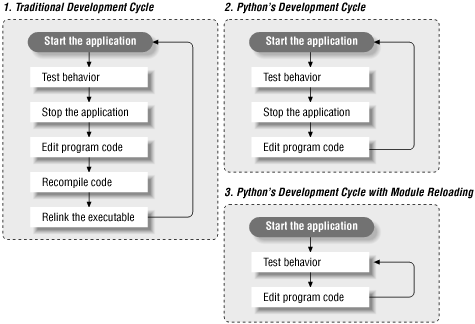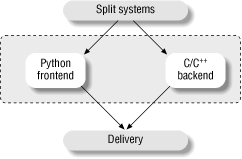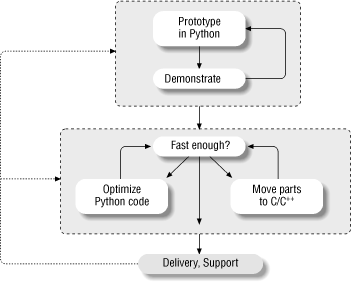But What About That Bottleneck?
Back to our original question: how can the act of writing software be made easier? At some level, Python is really "just another computer language." Its certainly true that Python the language doesn represent much thats radically new from a theoretical point of view. So why should we be excited about Python when so many languages have been tried already?
What makes Python of interest, and what may be its larger contribution to the development world, is not its syntax or semantics, but its world view: Pythons combination of tools makes rapid development a realistic goal. In a nutshell, Python fosters rapid development by providing features like these:
- Fast build-cycle turnaround
- A very high-level, object-oriented language
- Integration facilities to enable mixed-language development
Specifically, Python attacks the software development bottleneck on four fronts, described in the following sections.
.6.1 Python Provides Immediate Turnaround
Pythons development cycle is dramatically shorter than that of traditional tools. In Python, there are no compile or link steps -- Python programs simply import modules at runtime and use the objects they contain. Because of this, Python programs run immediately after changes are made. And in cases where dynamic module reloading can be used, its even possible to change and reload parts of a running program without stopping it at all. Figure 21-1 shows Pythons impact on the development cycle.
Figure 21-1. Development cycles

Because Python is interpreted, theres a rapid turnaround after program changes. And because Pythons parser is embedded in Python-based systems, its easy to modify programs at runtime. For example, we saw how GUI programs developed with Python allow developers to change the code that handles a button press while the GUI remains active; the effect of the code change may be observed immediately when the button is pressed again. Theres no need to stop and rebuild.
More generally, the entire development process in Python is an exercise in rapid prototyping. Python lends itself to experimental, interactive program development, and encourages developing systems incrementally by testing components in isolation and putting them together later. In fact, weve seen that we can switch from testing components (unit tests) to testing whole systems (integration tests) arbitrarily, as illustrated in Figure 21-2.
Figure 21-2. Incremental development

.6.2 Python Is "Executable Pseudocode"
Pythons very high-level nature means theres less for us to program and manage. Lack of compile and link steps isn really enough to address the development- cycle bottleneck by itself. For instance, a C or C++ interpreter might provide fast turnaround but still be almost useless for rapid development: the language is too complex and low-level.
But because Python is also a simple language, coding is dramatically faster too. For example, its dynamic typing, built-in objects, and garbage collection eliminate much of the manual bookkeeping code required in lower-level languages such as C and C++. Since things like type declarations, memory management, and common data structure implementations are all conspicuously absent, Python programs are typically a fraction of the size of their C or C++ equivalents. Theres less to write and read, and thus less opportunity for coding errors.
Because most bookkeeping code is missing, Python programs are easier to understand and more closely reflect the actual problem they e intended to address. And Pythons high-level nature not only allows algorithms to be realized more quickly, but also makes it easier to learn the language.
.6.3 Python Is OOP Done Right
For OOP to be useful, it must be easy to apply. Python makes OOP a flexible tool by delivering it in a dynamic language. More importantly, its class mechanism is a simplified subset of C++s, and its this simplification that makes OOP useful in the context of a rapid-development tool. For instance, when we looked at data structure classes in this book, we saw that Pythons dynamic typing let us apply a single class to a variety of object types; we didn need to write variants for each supported type.
In fact, Pythons OOP is so easy to use that theres really no reason not to apply it in most parts of an application. Pythons class model has features powerful enough for complex programs, yet because they e provided in simple ways, they don interfere with the problem we e trying to solve.
.6.4 Python Fosters Hybrid Applications
As weve seen earlier in this book, Pythons extending and embedding support makes it useful in mixed-language systems. Without good integration facilities, even the best rapid-development language is a "closed box" and not generally useful in modern development environments. But Pythons integration tools make it usable in hybrid, multicomponent applications. As one consequence, systems can simultaneously utilize the strengths of Python for rapid development, and of traditional languages such as C for rapid execution.
While its possible to use Python as a standalone tool, it doesn impose this mode. Instead, Python encourages an integrated approach to application development. By supporting arbitrary mixtures of Python and traditional languages, Python fosters a spectrum of development paradigms, ranging from pure prototyping to pure efficiency. Figure 21-3 shows the abstract case.
Figure 21-3. The development mode "slider"

As we move to the left extreme of the spectrum, we optimize speed of development. Moving to the right side optimizes speed of execution. And somewhere in between is an optimum mix for any given project. With Python, not only can we pick the proper mix for our project, but we can also later move the RAD slider in the picture arbitrarily as our needs change:
- Going to the right
-
Projects can be started on the left end of the scale in Python and gradually moved toward the right, module by module, as needed to optimize performance for delivery.
- Going to the left
-
Similarly, we can move strategic parts of existing C or C++ applications on the right end of the scale to Python, to support end-user programming and customization on the left end of the scale.
This flexibility of development modes is crucial in realistic environments. Python is optimized for speed of development, but that alone isn enough. By themselves, neither C nor Python is adequate to address the development bottleneck; together, they can do much more. As shown in Figure 21-4, for instance, apart from standalone use, one of Pythons most common roles splits systems into frontend components that can benefit from Pythons ease-of use and backend modules that require the efficiency of static languages like C, C++, or FORTRAN.
Whether we add Python frontend interfaces to existing systems or design them in early on, such a division of labor can open up a system to its users without exposing its internals.
Figure 21-4. Hybrid designs

When developing new systems, we also have the option of writing entirely in Python at first and then optimizing as needed for delivery by moving performance-critical components to compiled languages. And because Python and C modules look the same to clients, migration to compiled extensions is transparent.
Prototyping doesn make sense in every scenario. Sometimes splitting a system into a Python frontend and a C/C++ backend up front works best. And prototyping doesn help much when enhancing existing systems. But where it can be applied, early prototyping can be a major asset. By prototyping in Python first, we can show results more quickly. Perhaps more critically, end users can be closely involved in the early stages of the process, as sketched in Figure 21-5. The result is systems that more closely reflect their original requirements.
Figure 21-5. Prototyping with Python

Introducing Python
- And Now for Something Completely Different
- The Life of Python
- The Compulsory Features List
- Whats Python Good For?
- Whats Python Not Good For?
Part I: System Interfaces
System Tools
- The os.path to Knowledge
- Why Python Here?
- System Scripting Overview
- The sys Module
- The os Module
- Script Execution Context
- Current Working Directory
- Command-Line Arguments
- Shell Environment Variables
- Standard Streams
- File Tools
- Directory Tools
Parallel System Tools
- Telling the Monkeys What to Do
- Forking Processes
- Threads
- Program Exits
- Interprocess Communication
- Pipes
- Signals
- Launching Programs on Windows
- Other System Tools
Larger System Examples I
- Splits and Joins and Alien Invasions
- Splitting and Joining Files
- Generating Forward-Link Web Pages
- A Regression Test Script
- Packing and Unpacking Files
- User-Friendly Program Launchers
Larger System Examples II
- The Greps of Wrath
- Fixing DOS Line Ends
- Fixing DOS Filenames
- Searching Directory Trees
- Visitor: Walking Trees Generically
- Copying Directory Trees
- Deleting Directory Trees
- Comparing Directory Trees
Part II: GUI Programming
Graphical User Interfaces
- Heres Looking at You, Kid
- Python GUI Development Options
- Tkinter Overview
- Climbing the GUI Learning Curve
- The End of the Tutorial
- Python/Tkinter for Tcl/Tk Converts
A Tkinter Tour, Part 1
- Widgets and Gadgets and GUIs, Oh My!
- Configuring Widget Appearance
- Toplevel Windows
- Dialogs
- Binding Events
- Message and Entry
- Checkbutton, Radiobutton, and Scale
- Running GUI Code Three Ways
- Images
A Tkinter Tour, Part 2
- On Todays Menu: Spam, Spam, and Spam
- Menus
- Listboxes and Scrollbars
- Text
- Canvas
- Grids
- Time Tools, Threads, and Animation
- The End of the Tour
- The PyDemos and PyGadgets Launchers
Larger GUI Examples
- Building a Better Mouse Trap
- Advanced GUI Coding Techniques
- Complete Program Examples
- PyEdit: A Text Editor Program/Object
- PyView: An Image and Notes Slideshow
- PyDraw: Painting and Moving Graphics
- PyClock: An Analog/Digital Clock Widget
- PyToe: A Tic-Tac-Toe Game Widget
- Where to Go from Here
Part III: Internet Scripting
Network Scripting
- Tune in, Log on, and Drop out
- Plumbing the Internet
- Socket Programming
- Handling Multiple Clients
- A Simple Python File Server
Client-Side Scripting
- Socket to Me!
- Transferring Files over the Net
- Processing Internet Email
- The PyMailGui Email Client
- Other Client-Side Tools
Server-Side Scripting
- Oh What a Tangled Web We Weave
- Whats a Server-Side CGI Script?
- Climbing the CGI Learning Curve
- The Hello World Selector
- Coding for Maintainability
- More on HTML and URL Escapes
- Sending Files to Clients and Servers
Larger Web Site Examples I
- Things to Do When Visiting Chicago
- The PyMailCgi Web Site
- The Root Page
- Sending Mail by SMTP
- Reading POP Email
- Utility Modules
- CGI Script Trade-offs
Larger Web Site Examples II
- Typos Happen
- The PyErrata Web Site
- The Root Page
- Browsing PyErrata Reports
- Submitting PyErrata Reports
- PyErrata Database Interfaces
- Administrative Tools
- Designing for Reuse and Growth
Advanced Internet Topics
- Surfing on the Shoulders of Giants
- Zope: A Web Publishing Framework
- HTMLgen: Web Pages from Objects
- JPython ( Jython): Python for Java
- Grail: A Python-Based Web Browser
- Python Restricted Execution Mode
- XML Processing Tools
- Windows Web Scripting Extensions
- Python Server Pages
- Rolling Your Own Servers in Python
Part IV: Assorted Topics
Databases and Persistence
- Give Me an Order of Persistence, but Hold the Pickles
- Persistence Options in Python
- DBM Files
- Pickled Objects
- Shelve Files
- SQL Database Interfaces
- PyForm: A Persistent Object Viewer
Data Structures
- Roses Are Red, Violets Are Blue; Lists Are Mutable, and So Is Class Foo
- Implementing Stacks
- Implementing Sets
- Binary Search Trees
- Graph Searching
- Reversing Sequences
- Permuting Sequences
- Sorting Sequences
- Data Structures Versus Python Built-ins
- PyTree: A Generic Tree Object Viewer
Text and Language
- See Jack Hack. Hack, Jack, Hack
- Strategies for Parsing Text in Python
- String Module Utilities
- Regular Expression Matching
- Parser Generators
- Hand-Coded Parsers
- PyCalc: A Calculator Program/Object
Part V: Integration
Extending Python
- Extending Python
- I Am Lost at C
- C Extensions Overview
- A Simple C Extension Module
- The SWIG Integration Code Generator
- Wrapping C Environment Calls
- A C Extension Module String Stack
- A C Extension Type String Stack
- Wrapping C++ Classes with SWIG
Embedding Python
- Embedding Python
- Add Python. Mix Well. Repeat.
- C Embedding API Overview
- Basic Embedding Techniques
- Registering Callback Handler Objects
- Using Python Classes in C
- ppembed: A High-Level Embedding API
- Other Integration Topics
VI: The End
Conclusion Python and the Development Cycle
- Conclusion Python and the Development Cycle
- That s the End of the Book, Now Here s the Meaning of Life
- Something s Wrong with the Way We Program Computers
- The Gilligan Factor
- Doing the Right Thing
- Enter Python
- But What About That Bottleneck?
- On Sinking the Titanic
- So What s Python The Sequel
- In the Final Analysis
- Postscript to the Second Edition
- Appendix A Recent Python Changes
- Section A.1. Major Changes in 2.0
- Section A.2. Major Changes in 1.6
- Section A.3. Major Changes Between 1.3 and 1.5.2
- Appendix B Pragmatics
- Section B.1. Installing Python
- Section B.2. Book Examples Distribution
- Section B.3. Environment Configuration
- Section B.4. Running Python Programs
- Section B.5. Python Internet Resources
- Appendix C. Python Versus C++
EAN: 2147483647
Pages: 245
